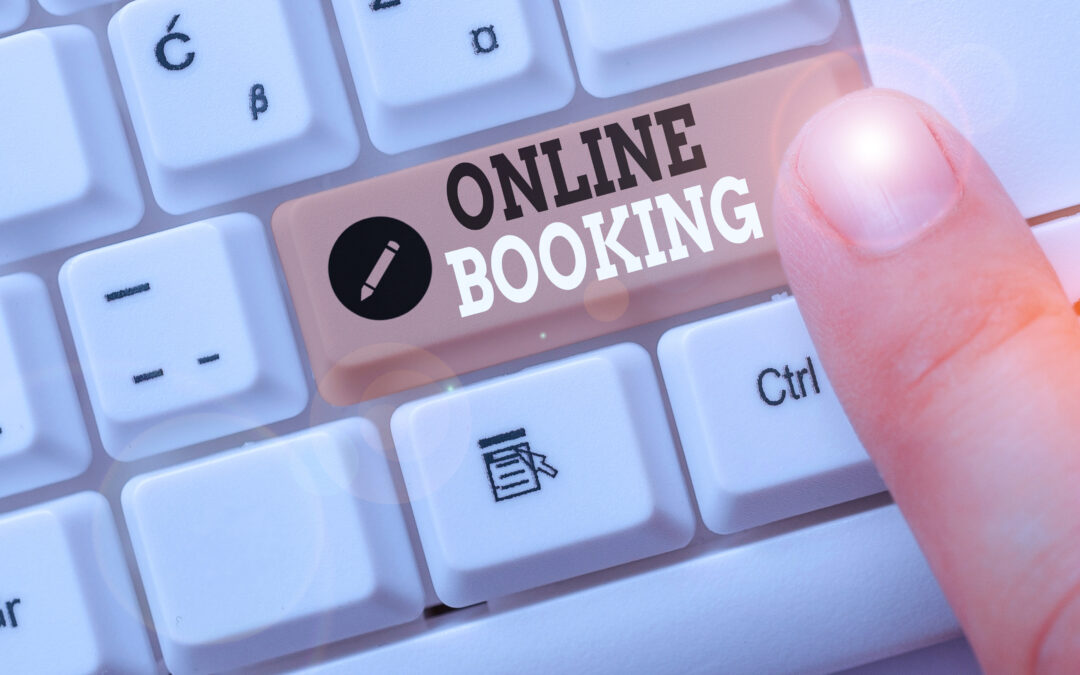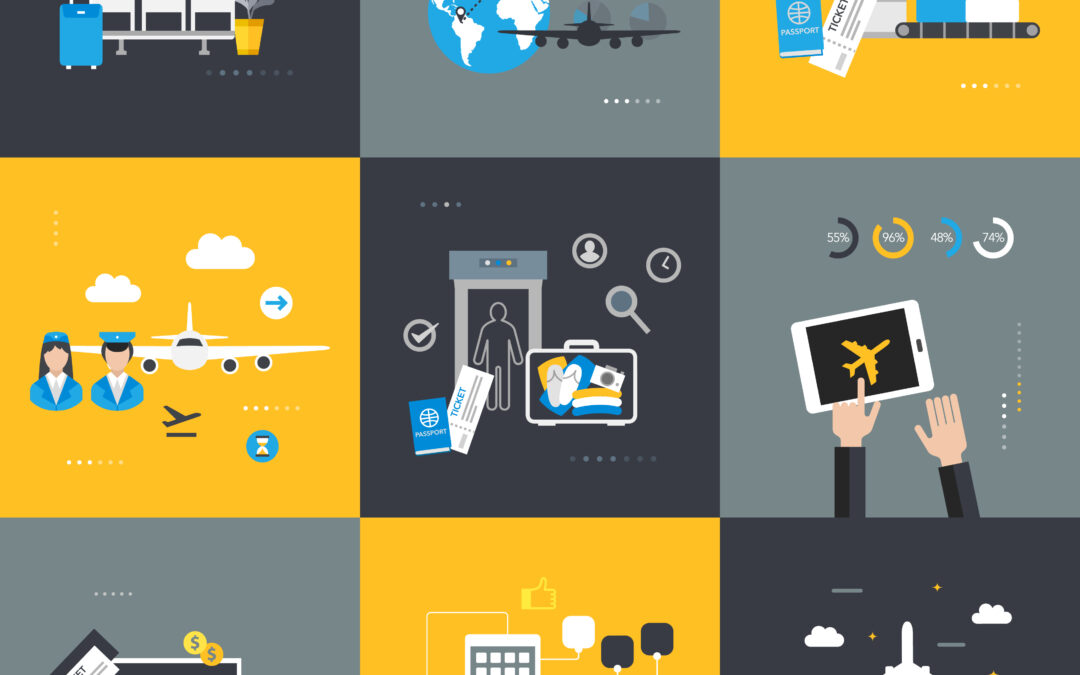
by Dave Stevenson | Oct 3, 2019 | Trondent Blog
Corporations often require that their employees travel for overnight or more extensively to stay competitive. Although it may be good for the business, it can be taxing on the traveler. Frequent corporate travel has been shown to cause high degrees of stress as travelers must forego quality time with family or friends, disrupt their routines and skip full nights of sleep.
It’s a proven fact that healthier employees have higher work performance, so it is important to support your corporate travelers by promoting healthy travel habits and wellness programs. Here are some ways to ensure that your employees sustain optimal health on the road.
Encourage Ideal Flight Times
Avoiding fatigue is one of the main difficulties with which your frequent travelers must contend. Red eye flights, sleepless nights and absurdly early mornings deplete them. A recent study conducted by GBTA showed that more corporations now allow business travelers the choice for flight arrival/departure times that match their needs. This increases traveler satisfaction and performance levels.
Offer Wellness Programs
Keeping employees happy and healthy on the road pays big dividends. Interestingly, one of the best ways to support traveler health is back at the office! Corporations have begun to recognize that wellness programs offered in-house can decrease employee turnover and yield a highly sought-after talent pool. Wellness programs help travelers to feel valued, and, in turn, their performance improves. Successful examples of wellness programs include:
- Flexible work hours
- On-site fitness classes
- Healthy office snacks
- Remote working days
- Screenings and health assessments
- Employee lounge
- Reward for loyalty, performance, or meeting a physical goal
While some of these ideas are great, they may not be appropriate for all businesses. Travel managers can survey employees for suggestions to begin a wellness program or to revamp one that is already in place.
Promote Exercise on the Road
It is especially challenging to stick with any kind of a work-out schedule when travelers are suffering from jet lag, balancing a hectic schedule, and adapting to different time zones. Emphasize to your travelers how important it is to exercise even on the road and make it accessible for them to do so by selecting hotel suppliers with fitness centers onsite.
If the hotel is located in a well-lit and well-traveled area of the city, travelers might be inclined to take a walk or a run outdoors for exercise as well.
Travel Hacks to Stay Fit
When people are sufficiently motivated to look after their health, they will stick with it even during business travel. Travel managers can prevent travelers from backsliding while on the road by providing a list of helpful fitness and nutrition apps in the corporate intranet portal for their travelers to download.
Apps like BeachBody and Les Mills On Demand offer fitness routines that travelers can do anywhere without gym equipment. Headspace has meditations to reduce stress. Nutrition apps like the CDC food app, GF (gluten free app) or Happy Cow (vegan-friendly app) help travelers identify healthy restaurants nearby.
Frequent travel wreaks havoc on travelers’ diet. A change in types of food, food preparation, water and environment often play a role in how we feel.
Offer your travelers tips like these to stay healthy on the road:
- Pack healthy snacks to avoid grab-and-go at the airport
- Exercise (even if you do not feel like it)
- Remain hydrated
- Eat breakfast
- Get enough sleep
- Plan ahead whether it is for a dinner with clients or snacks in the office.
- Partner with a colleague to help you stay accountable.
- Utilize fitness & nutrition apps
Precautions While Traveling
Most corporate travel managers consider both safety and well-being bundled together as a part of their Duty of Care. Your employees must understand how to stay safe in strange neighborhoods and hotels by using certain precautions. Business travelers should always have a smartphone with emergency contact telephone numbers, and a manager should know where employees are located at different times of the day or the night.
Traveler Health is in Best Interest of the Corporation
Because decreased productivity often is the result of deteriorating physical and mental capacity, it behooves the corporation to ensure, as much as feasible, that their employees remain as healthy as possible when they are away on business trips. We hope these tips and strategies will help you promote healthy habits for your business travelers.

by Dave Stevenson | Sep 16, 2019 | Trondent Blog
Duty of Care risk mitigation is a migraine headache for corporations to manage. Why? Because travel considerations are as diverse as the travelers themselves: gender, sexual orientation, disabilities, religious observances, etc. Something as simple as having one of your business travelers snap a photo of a government building could get him arrested. No joke.
Once those considerations are accounted for, there remain countless other risks or threats from seen and unseen sources. There are obvious risks for auto or aircraft accidents, natural catastrophes or terrorism to contend with. But, there are more subtle threats too. For example, it might not be wise to send an employee from your Saudi office to Europe during Ramadan where it is not practiced. Nor would it be wise to send one of your employees from the LGBTQ community to any of the 70 countries that still consider it a crime.
To say it’s merely “a challenge” to manage corporate travel risk is an understatement. We all know that corporations have the moral and ethical obligation to keep their employees safe when they travel for business. But what exactly can be done? Where do you start? Once you have a risk mitigation program in place, how do you refresh and refine it?
Rally the Troops
Travel is one of the few departments within an organization that affects everyone. As such, it is critical to get as many voices in harmony as you can. Human Resources, Security, Legal, IT and Finance need to collaborate with the Travel department for a holistic perspective on risk mitigation. Each party brings an invaluable contribution to identify risk, alleviate it, insure against it or decide what actionable steps meet traveler safety and security.
How to Prepare Travelers
The biggest issue with business travel risk is lack of traveler awareness. Remember that guy who got arrested simply for snapping a photo of a government building? Nobody warned him that was illegal.
Think hard about what information you can provide in advance for your traveler. Pre-travel advisory at the start can address issues before a traveler winds up in sketchy situations on the road. The traveler has to be aware of exactly what they’re getting into.
Communicate safe travel practices, ensuring employees receive appropriate vaccinations, and ensuring the traveler has an understanding of their responsibility as identified in your formal travel risk plan.
In addition to equipping your travelers with information in advance, some corporations have taken to offering highly-niche training such as pre-travel trauma training and self-preservation training to teach women how to identify threatening situations and how to back away from it.
Business Travel Risk Mitigation
It is the travel department’s responsibility to be proactive and find out what special needs exist among their travelers. One person might feel perfectly comfortable flying to Russia, while another may not. It is an objective balancing act between policy and people’s feelings.
Establish a method of communication between business travelers and the Travel Department. Make sure you have a form for business travelers to complete or a method for them to communicate their special considerations with the travel department, be it gender, sexual orientation or disabilities. Perhaps a designated email address that allows travelers to directly communicate with Travel like travel@yourcompanyname.com.
When you are contracting with hotel vendors, select those that have non-discrimination policies in place. Build the dangerous regions and their risk levels into pre-trip authorization technology like Authorizer PRO so that trip requests are evaluated before they get ticketed. Workflow systems can incorporate alerts to other departments within the organization who need to be in the loop about traveler safety and security.
Utilize travel intelligence available from companies like World Aware. They provide reports on neighborhood safety ratings and incidents alerts/warnings. Companies engaged in third party risk management can offer pre-travel awareness and advisory for travelers traveling abroad down to a list of immunizations required to travel to certain regions of the world. They can also give you information specific to women and LGBTQ both legal and cultural implications.
Make it a priority to consult online resources that identify dangerous regions around the globe. The US Department of State divides countries into certain risk levels as well have offers sections that explain certain local circumstances and cultural considerations for free. Sign up for Overseas Security Advisory Council (US-Centric, free to sign up for alerts to find out where tensions are high around the world). Even if you’re an international organization, you still have access to some of the OSAC information. For example, in early August 2019 Saudi Arabian law changed to permit women to travel without male accompaniment, so OSAC alerted its subscribers. Alerts like that are helpful.
Refresh and Refine Your Risk Mitigation Plan
Over 80% of GBTA members surveyed said they have not revisited their risk mitigation plan since its implementation. While there are no “official” guidelines for corporate responsibility of risk management, corporations must protects themselves from liability by protecting their business travelers. In addition to the suggestions and sites presented in this article, here are a few more sites to bookmark as you revisit your travel risk management program:
UK Foreign Commonwealth Office – www.fco.gov.uk
Government of Canada – www.travel.gc.ca
International LGBTI – www.ilga.gov
International Association for Medical Assistance for Travelers – www.iamat.org
European Union Airline Safety Ban List – ec.europa.eu/transport/modes/air/safety/air-ban.en

by Dave Stevenson | Sep 16, 2019 | Trondent Blog
Booking corporate travel is something that can easily become time consuming and overwhelming, especially if it’s not your area of expertise. Large corporations sometimes choose to hire third-party travel agencies to handle all of the details, while others have in-house travel buyers who are well-versed in handling travel arrangements for the company.
However, as the popularity of consumer-focused travel booking sites has exploded, there has also been a surge of interest in corporate online booking tools as well.
Online Booking Tools 101
Online booking tools are quickly becoming the standard for booking business trips in a budget-friendly manner.
Unlike consumer-facing price comparison sites like Travelocity and the like, corporate online booking tools, or OBTs, have the express purpose of functioning as efficient and convenient ways to book business travel. They can be used by corporate travel managers, but they can also be accessed by employees, which can help businesses save time and money.
Like any other business tool, OBTs have both positive and negative aspects. Here is an overview list of the pros and cons that can help you decide if OBTs are right for your company.
How OBTs Can Help You
There are several advantages to choosing OBTs for your company’s travel booking.
Instant Access
With travel agencies, you are restricted to booking during working hours and availability. Online booking tools allow your business to create and change travel plans 24 hours a day, which is incredibly helpful for last-minute bookings or emergency changes.
Almost all OBTs have a mobile interface as well, and this makes them even more convenient because anyone can access and update his or her itinerary from a smartphone or tablet.
Better Deals
OBTs can aggregate a huge amount of data in seconds. They can help you to find bookings that fit into your travel policy as well as your budget constraints. This often means that you can find lower-than-average ticket prices and reservations without compromising the comfort of your staff.
Compliance and Compatibility
Instead of spending time researching every little detail to ensure that travel bookings meet Duty of Care compliance standards, most OBTs allow you to set custom filters that only show you listings that comply with your company’s travel policy.
In this same vein, OBTs can be configured to communicate smoothly with your reporting tools. This lets you gather data seamlessly and sync it with corporate dashboards and profile management systems.
All this sounds ideal, but there are limitations of online booking tools.
Configuration Restrictions
While it’s true that you can filter search results in order to find better deals on bookings, it’s important to understand that most OBTs coding configuration for out-of-policy bookings are limited, allowing only basic rules. Corporations struggle to find a platform that can accommodate more complex booking scenarios. This is why pre-travel approval software must be integrated into the OBT to enable a corporation to impart its entire travel policy into the booking process.
Trondent’s pre-travel approval software Authorizer PRO integrates with any GDS, travel agency or online booking tool. Authorizer PRO has an unlimited number of rules available for an unlimited number of trip approvers of all levels within the organization. Its capacity for intricate workflow makes it an attractive investment for large corporations with robust travel policies who seek to improve policy compliance and eliminate wasteful spend.
No Live Support
When you book with a travel agency, you are paying for more than just an expertly planned trip. You are also paying for access to an informed agent who speaks your native language and can help you navigate through unexpected or difficult situations while you are away.
Using travel management software may eliminate the need for booking through an agent, but it also takes away your access to human support if you need it. This is an especially important thing to consider if your trips frequently require complex itineraries or multiple modes of transportation.
Data Dependent
This last drawback is twofold. First, opting to book with an OBT means that, for the duration of your trip, your access to reservation information, itinerary updates and other crucial information is completely dependent on having a reliable internet or data connection. If you are traveling abroad or going to an unfamiliar or remote location, this can be extremely problematic.
The second issue involves your personal data. Online booking tools have become attractive targets for cyber criminals. While it is possible for any company that utilizes the internet to experience a security breach, third-party agencies typically have access to highly secure travel management software that minimizes this risk.
Online Booking Tools Are Changing the Face of Corporate Travel
There are plenty of reasons to sing the praises of OBTs, but there are also drawbacks that should be carefully considered. If your corporation truly wants to automate its policy, it needs to seek the assistance of pre-travel approval software.
As technology progresses and corporations become more accustomed to the convenience and efficiency of utilizing OBTs, it is likely that the entire industry of business travel will become centered around these new tools.

by Dave Stevenson | Aug 7, 2019 | Trondent Blog
Have you stopped to think about what goes into corporate travel? How large it is? Who is traveling most? What travelers do and don’t like about it? We trolled the internet to round up the latest and greatest statistics about corporate travel. Let’s take a good look inside the corporate travel industry by the numbers!
How Big is Corporate Travel?
Corporate Travel is a trillion-dollar industry! The U.S. and China are the world’s biggest business travel spenders.
Americans make more than 405 million long-distance business trips per year. This means about 1.1 million people are traveling for business every day in the U.S. The Big Apple – New York City – is the most common business travel destination, though the fastest growing business travel destination is Shanghai.
Business passengers represent 75 percent of an airline’s profits despite only being 12% of their total passengers. But the money is well spent: every $1.00 spent on business travel creates $15 of profit for increased sales.
Business Traveler Preferences
How are business travelers booking their travel? We know that 79% of corporate travelers used their mobile phones to complete bookings through on online booking tool last year.
Whoever thought that one day we’d be booking flights from the palms of our hands? But, from 2016-2017, the number of people who booked travel plans solely from their mobile devices rose a whopping 70%. Plus, over 23% of all business flights are booked outside of standard business hours these days. That tells us that not only are business men and women using their phones to book travel, they’re doing so outside the office.
Sadly, 23% of business travelers wait until the week before departure to book domestic trips, which decreases policy compliance especially because rates increase dramatically the closer you get to your travel date. Flights wind up costing more than policy allows and exceeds company budgets!
Alas, technology cannot replace connecting in person. Nearly 70% of business travelers agree it is difficult to build business relationships over video and 91% agree they’d rather close a deal in person. Thus, the infamous “business trip” shall go on.
For most business travelers, their frustration begins with booking the trip. 83% of business people said it takes more than an hour to book a business trip. But, booking travel is not their biggest pain point.
When they travel, what is the biggest concern for business people? The #1 corporate travel concern by airplane passengers is flight delays. The second concern? A middle seat!
Where is the money going?
Would you believe it if I told you that the majority of companies’ travel budgets is spent on meals? Corporate Travelers expense up to 3 billion dollars in fast food every year!
The next 17% of a corporate travel budget is spent on flights, 13% on hotels, and the remaining 49% is spent on everything from tolls to gas and miscellaneous expenses.
What do you think is the #1 most important factor for business people booking hotel accommodations? Nope, not price! It’s proximity. The location of a hotel close to the meeting destination is the most important factor for corporate travelers when deciding where they want to lodge. This can also cost the company more money since paying for location tends to be higher.
What’s the Deal with Travel Policy?
Despite the massive amount of employees who travel for business, only 60% of companies have a corporate travel policy in place for employees to follow. Of corporations that do have a policy, most employees report that they do comply with it. In fact, a Travelport study reported that 69% of business travelers say they “always comply with policy”.
We think that number is a bit optimistic, otherwise travel managers would not struggle so much to meet their budgets. In a separate study by Amadeus, only 50% of travelers said they followed company policy. What’s more troubling is that in this same study, 60% of business travelers admitted they don’t even understand their company’s travel policy.
Speaking of travel managers, when asked if they feel confident that they could locate traveling employees in a crisis within two hours, only half agreed that they could. Moreover, only 8% of travelers reported that their travel agent proactively reaches out when plans unexpectedly change.
Millennials
Even though the average age of a corporate traveler is 45 years, millennials are impacting corporate travel in significant ways. First, they’re spending more time on the road when they do travel. The average business traveler takes around 6.8 trips a year, but millennials average 7.4 trips per year.
Apparently, the younger members of the workforce aren’t complaining about having to travel for work. Most of them consider business travel to be a perk of the job, and 65% of them see it as a status symbol.
Millennials have boujee preferences too. They are 60% more likely to upgrade for more legroom on flights than non-millennials. Further, 21% of millennials do not belong to any loyalty program and are less interested in loyalty programs in general. Too much commitment. Though they are game to ride-share with services like Uber so in some small way they’re saving the company cents.
The most significant impact by millennials on corporate travel has been the increase in “Bleisure” trips that have increased over 20% in recent years and continues to rise.
The Future of Business Travel
The outlook for global travel spending is expected to reach $1.7 trillion dollars by 2022. While current global trade tensions are suspected to slow international business travel slightly, it will continue to rise overall.
Business travelers are changing, and business travel tools are evolving with them. Today’s business traveler wants a seamless experience with flexible choices and dynamic business policies. Trondent can help your corporation achieve this experience and save time and money for both traveler and the company.
We can do this through our profile management system that allows corporations to easily track where they’re employees are during emergencies and through our pre-trip authorization solution that makes it easier for employees to book their trips within company policy! To learn more about these fabulous software platforms, reach out to our team today!

by Dave Stevenson | Jul 15, 2019 | Trondent Blog
Business travel trends come and go, but few generate as much buzz as “bleisure.” Would you believe me if I told you that bleisure is actually a very conventional practice, just under a fresh marketing term? In fact, there has always been a decent segment of the business travel population with the means and professional flexibility to add leisure days onto business trips.
While vacationing before, during or after a business trip is not new, the fact that corporations are re-writing their travel policies to accommodate it is the real trend unfolding here.
Bliesure is NOT New
If anything, bleisure is old news. The main difference is that today’s corporations are looking for creative ways to attract top talent, boost employee benefits, and retain key players. As such, they seek to rectify travel policies so that they include perks like Bliesure.
Executive travelers have always enjoyed the privilege to extend their business trips here and there, but it just wasn’t discussed as an option for all employees. Now that the corporate culture has shifted to emphasize employee’s overall well-being, we are seeing that luxury opening up to all.
A lack of generational workforce research makes it hard to compare today’s business travelers to their predecessors of the 1980s and 1990s. As more companies offer travel policies that accommodate sightseeing, tourism and similar diversions, however, bleisure is steadily growing as an employment benefit. Therein lies the real trend.
Even though most modern companies value employee wellness, some may have a hard time getting behind lenient travel policies.
The Marketing Angle
Travel advertising is the principal motivation behind the meteoric rise of the so-called bleisure trend. Tour agents and companies love outreach gimmicks, so latching on to the concept of rewarding business travel seemed like a natural fit. Bleisure gives them the opportunity to sell more sightseeing packages.
Still, leading enterprises recognize the value of employee satisfaction and work-life balance. They’ve learned that offering superior benefits like Bliesure helps them
- Retain more qualified employees
- Stay competitive in the hiring arena
- Build camaraderie and establish rewarding corporate cultures around shared experiences
- Reduce workplace stress
- Increase productivity
Paving the Way with Travel Policy
Thinkific, a Vancouver software firm, extended its bleisure travel program beyond the norm. Instead of only permitting top executives to stretch corporate trips for leisure purposes, the firm gave all of its employees the leeway to explore, enjoy mini-vacations and visit family members en route.
According to HR specialists, such policies go beyond helping employees trade stress for productivity. They also attract top talent, which makes sense in an employment landscape where many workers view business travel employment as a desirable status symbol.
Travel experts note that permitting bleisure travel doesn’t necessarily mean sanctioning free-for-all risk-taking. As always, it’s wise to help your travelers steer clear of situations that might place them or your reputation in harm’s way. For instance, you might restrict the number of days that employees can spend vacationing in certain places or prohibit them from participating in controversial or life-threatening activities.
Incorporating Bleisure Into Travel Program
The most effective way to manage trip-extension requests is to craft an agile travel policy that anticipates such demands. Your company travel policy needs to educate employees about the legal responsibilities and personal liabilities they take on when they decide to vacation following a business trip. Corporations can clearly define which expenses they’ll subsidize and which employees will have to cover out of pocket.
Greasing the gears of progress with a better travel system can make bleisure far more manageable for everyone involved. If your booking tool helps your employees find cost-saving fares, then they might be more apt to make budget-friendly requests.
Try to make your pre-trip authorization process straightforward so that it doesn’t represent an excessive burden. Trondent’s pre-trip authorization platform, Authorizer PRO, allows you set the tone with as many rules as you need to accommodate the way your employees travel.
Letting your employees integrate bleisure into their normal trip planning activities could be the simplest way to keep them happy. By utilizing more robust travel management solutions that can easily manage bliesure trip requests, you can streamline business travel programme. To get started, talk to a Trondent expert today.





